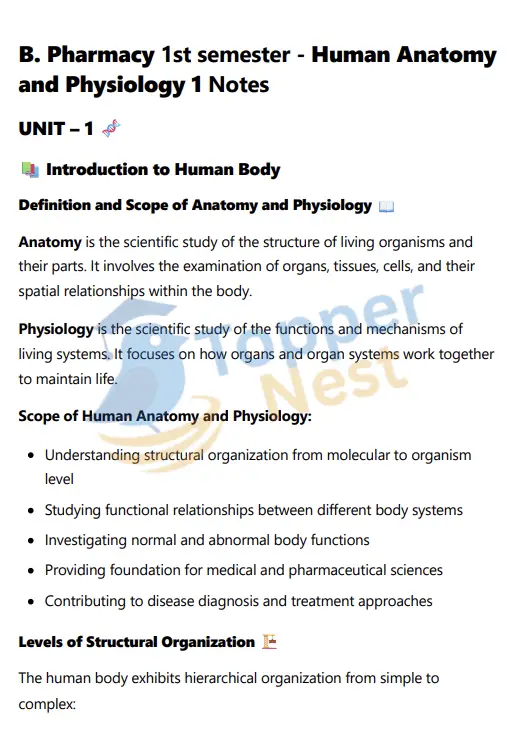Understanding the human body is the foundation of every medical and pharmaceutical science. In B. Pharmacy, Human Anatomy and Physiology 1 introduces students to the body’s intricate systems from the cellular level to tissue organization. This unit covers fundamental concepts such as levels of structural organization, cell communication, and types of human tissues. Here’s a simplified breakdown of the first unit.

Introduction to the Human Body
Definition and Scope of Anatomy and Physiology
Anatomy is the study of body structures, while physiology explores how those structures function. Together, they form the scientific foundation for understanding human health and disease. In pharmacy, this knowledge is crucial for drug formulation, pathophysiology, and clinical applications.
Levels of Structural Organization The human body has several levels of organization:
- Chemical level (atoms and molecules)
- Cellular level (cells and organelles)
- Tissue level (groups of similar cells)
- Organ level (two or more tissues)
- System level (organ systems)
- Organism level (complete living being)
Body Systems Overview
The major body systems include the nervous system, cardiovascular system, digestive system, respiratory system, musculoskeletal system, and more. These systems work together to maintain homeostasis.
Definition of Cellular Level of Organization
The human body is made up of trillions of cells that work together to carry out essential life processes. Each cell is a complete unit capable of performing basic functions necessary for survival. Understanding the structure and function of cells helps us learn how the body grows, repairs itself, and responds to different stimuli.
- Cell Structure and Function – Cells contain various organelles such as the nucleus, mitochondria, and ribosomes, each responsible for specific cellular activities like energy production and protein synthesis.
- Transport Across Cell Membrane – Nutrients and waste products move in and out of cells through passive transport (like diffusion) and active transport (which requires energy).
- Cell Division – Mitosis helps in body growth and tissue repair, while meiosis is important for the formation of reproductive cells.
- Cell Junctions – These are specialized connections between cells (e.g., tight junctions and gap junctions) that help maintain tissue structure and enable communication.
- Intracellular Signaling – Cells communicate with each other through signaling molecules that activate specific pathways, leading to a cellular response.
- Types of Signaling – These include contact-dependent signaling (direct contact), paracrine signaling (local cell communication), synaptic signaling (via nerve impulses), and endocrine signaling (through hormones in the blood).
Definition of Tissue Level of Organization
When similar cells come together to perform a common function, they form tissues. The human body is made up of four primary types of tissues, each with a specific role in maintaining normal body function. These tissues form the structural and functional basis of organs and systems.
- Epithelial Tissue – Covers body surfaces and lines internal organs; it serves protective, absorptive, and secretory functions.
- Connective Tissue – Provides support and binds other tissues together; includes structures like bone, blood, cartilage, and tendons.
- Muscular Tissue – Responsible for movement of the body and internal organs; includes skeletal (voluntary), cardiac (heart), and smooth (involuntary) muscles.
- Nervous Tissue – Made up of neurons and supporting glial cells; it transmits electrical signals for coordination, sensation, and control.
Frequently Asked Questions (FAQs)
1. Why is understanding the cellular level important in pharmacy?
Because drugs often act at the cellular level, understanding how cells function helps pharmacy students grasp how medications work and how the body responds.
2. What is the role of cell signaling in the body?
Cell signaling allows cells to communicate and coordinate actions like growth, repair, immune response, and hormone regulation.
3. What is the difference between epithelial and connective tissue?
Epithelial tissue covers and protects surfaces, while connective tissue supports, connects, and binds other tissues and organs.
4. How does tissue organization relate to drug delivery?
Understanding tissues helps pharmacists design drug formulations that effectively target specific tissue types and minimize side effects.
5. What are examples of passive and active transport?
Passive transport includes diffusion and osmosis, which don’t require energy. Active transport requires energy, like the sodium-potassium pump.

Thank you so much for providing such informational contant